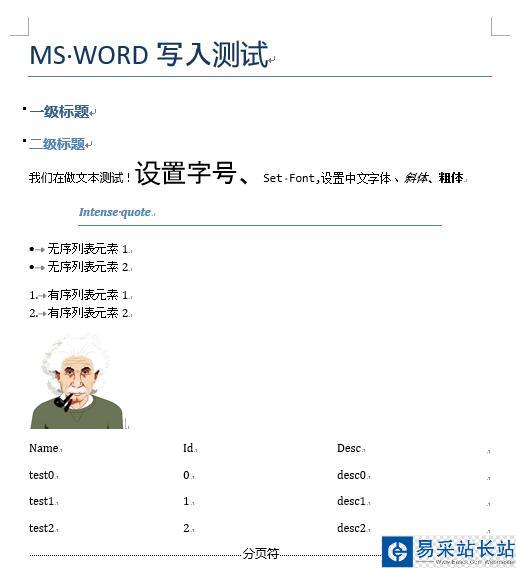使用python工具读写MS Word文件(docx与doc文件),主要利用了python-docx包。本文给出一些常用的操作,并完成一个样例,帮助大家快速入手。
安装
pyhton处理docx文件需要使用python-docx 包,可以利用pip工具很方便的安装,pip工具在python安装路径下的Scripts文件夹中
pip install python-docx
当然你也可以选择使用easy_install或者手动方式进行安装
写入文件内容
此处我们直接给出一个样例,根据自己的需要摘取有用的内容
#coding=utf-8from docx import Documentfrom docx.shared import Ptfrom docx.shared import Inchesfrom docx.oxml.ns import qn#打开文档document = Document()#加入不同等级的标题document.add_heading(u'MS WORD写入测试',0)document.add_heading(u'一级标题',1)document.add_heading(u'二级标题',2)#添加文本paragraph = document.add_paragraph(u'我们在做文本测试!')#设置字号run = paragraph.add_run(u'设置字号、')run.font.size = Pt(24)#设置字体run = paragraph.add_run('Set Font,')run.font.name = 'Consolas'#设置中文字体run = paragraph.add_run(u'设置中文字体、')run.font.name=u'宋体'r = run._elementr.rPr.rFonts.set(qn('w:eastAsia'), u'宋体')#设置斜体run = paragraph.add_run(u'斜体、')run.italic = True#设置粗体run = paragraph.add_run(u'粗体').bold = True#增加引用document.add_paragraph('Intense quote', style='Intense Quote')#增加无序列表document.add_paragraph( u'无序列表元素1', style='List Bullet')document.add_paragraph( u'无序列表元素2', style='List Bullet')#增加有序列表document.add_paragraph( u'有序列表元素1', style='List Number')document.add_paragraph( u'有序列表元素2', style='List Number')#增加图像(此处用到图像image.bmp,请自行添加脚本所在目录中)document.add_picture('image.bmp', width=Inches(1.25))#增加表格table = document.add_table(rows=1, cols=3)hdr_cells = table.rows[0].cellshdr_cells[0].text = 'Name'hdr_cells[1].text = 'Id'hdr_cells[2].text = 'Desc'#再增加3行表格元素for i in xrange(3): row_cells = table.add_row().cells row_cells[0].text = 'test'+str(i) row_cells[1].text = str(i) row_cells[2].text = 'desc'+str(i)#增加分页document.add_page_break()#保存文件document.save(u'测试.docx')该段代码生成的文档样式如下

注:有一个问题没找到如何解决,即如何为表格设置边框线。如果您知道,还请能够指教。
读取文件内容
#coding=utf-8from docx import Document#打开文档document = Document(u'测试.docx')#读取每段资料l = [ paragraph.text.encode('gb2312') for paragraph in document.paragraphs];#输出并观察结果,也可以通过其他手段处理文本即可for i in l: print i#读取表格材料,并输出结果tables = [table for table in document.tables];for table in tables: for row in table.rows: for cell in row.cells: print cell.text.encode('gb2312'),'/t', print print '/n'
新闻热点
疑难解答